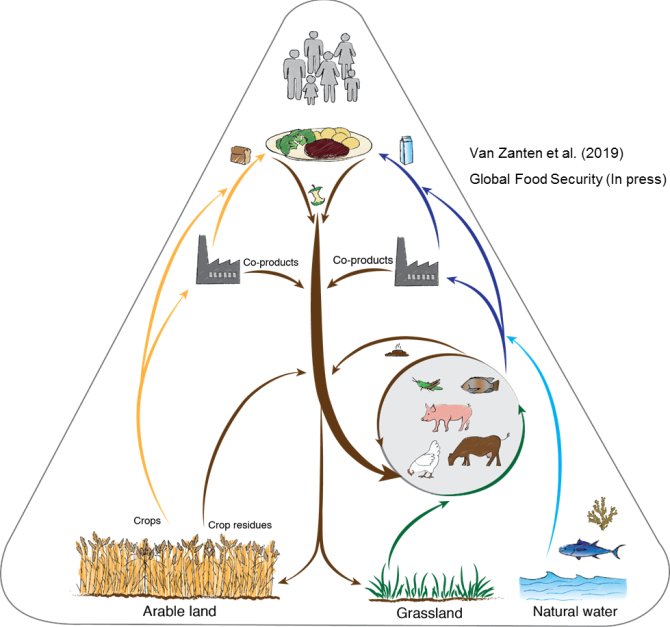
Impact story
Do animals have a role in future food systems?
Animals can convert leftovers from arable land and grass resources into valuable food and other ecosystem services. By converting these biomass streams, animals recycle nutrients into the food system that otherwise would have been lost for food production, thereby contributing to a circular food system.
Current situation
It is widely recognized that food production, especially animal production, generates a broad range of environmental impacts, increasing the pressure on the Earth’s system. The global animal sector is responsible for about 60% of all human-based greenhouse gas emissions from the food system and uses about 40% of all crop land. This crop land is used to produce high quality feed products that we humans could also eat, resulting in a competition for land between feed and food production, which threatens future food security. For these reasons, and other reasons, many people argue that we should reduce our consumption of animal-source food (ASF). A key question in feeding the future world, therefore, is: how much animal-source food should we eat?
Circular food system solution
We recently demonstrated that farm animals reared under a circular paradigm can play a crucial role in feeding humanity while decreasing the environmental impact. These farm animals would not consume human-edible biomass, such as grains, but mainly convert leftovers from arable land and grass resources into valuable food.
Plant biomass is the basis of a circular food system, and should be used primarily to produce human food. Leftovers from food production, such as crop residues, co-products from industrial food processing and unavoidable food waste (further referred to as low-opportunity-cost feeds), should be re-used or recycled into the food system, to fertilize crops, to feed the soil or to feed animals. Pigs, poultry, farmed fish or insects, for example, can utilize these leftovers and convert them into valuable food, manure and other ecosystem services. In addition ruminants can create nutritional value from grasslands by converting grass products into milk and meat (from e.g. culled cows and excess calves). By using these biomass streams, farm animals recycle nutrients into the food system that otherwise would have been lost in the process of food production.
The availability of these biomass streams for farm animals then determines the boundaries for animal production and consumption. Under this concept, the competition for land for feed or food would be minimized and compared to no animal-source food, including some animal-source food in the human diet could free up about one quarter of global arable land.
Feeding only low-opportunity-cost feeds to farm animals will however affect the availability of animal-source food for human consumption. Our first estimates show that this route can provide up to one third (9-23 g) of the daily protein needs of an average global citizen (~50-60 g; Van Zanten et al., 2018). The average protein supply in Europe is 51 g per person per day (excl. fish), implying that moving towards circularity would require a substantial reduction in the consumption – and hence production – of animal-source food. The exact reduction in the consumption of animal-source food in high-income countries needed, however, is not known and requires more research. To better understand the role of farm animals in future food systems, we need to answer questions like: which animals are best suited for which types of leftovers or grass resources, and which leftovers and grasslands can be considered available for animals?

New metrics required
To direct us towards animal farming that contributes to a circular food system, we are in need of (a smart combination of) new metrics. At present, product footprints are increasingly used by industry and society to reduce the environmental impact of food production. A product footprint quantifies the resource use or emissions along the entire life cycle of a food product; examples include the water or carbon footprint of a food product. The footprints of individual food products, however, fall short in addressing the complexity and circularity of food systems. For example, they do not acknowledge interlinkages in the food system. Feeding more concentrates instead of roughage to cattle, for example, would reduce the footprint of beef (De Vries et al., 2015), but at the same time increase feed-food competition and thus increase the land use of the entire food system (Van Zanten et al., 2018). Thus, such footprint assessments are not able to adequately capture environmental benefits of using low‐opportunity-cost feedstuff as livestock feed.
To move towards a sustainable food future which makes optimal use of the earth’s natural resources, therefore, we need to move away from the current product footprint approach and start using a food systems lens. Food systems analysis clearly shows that farm animals are key in circular food systems.